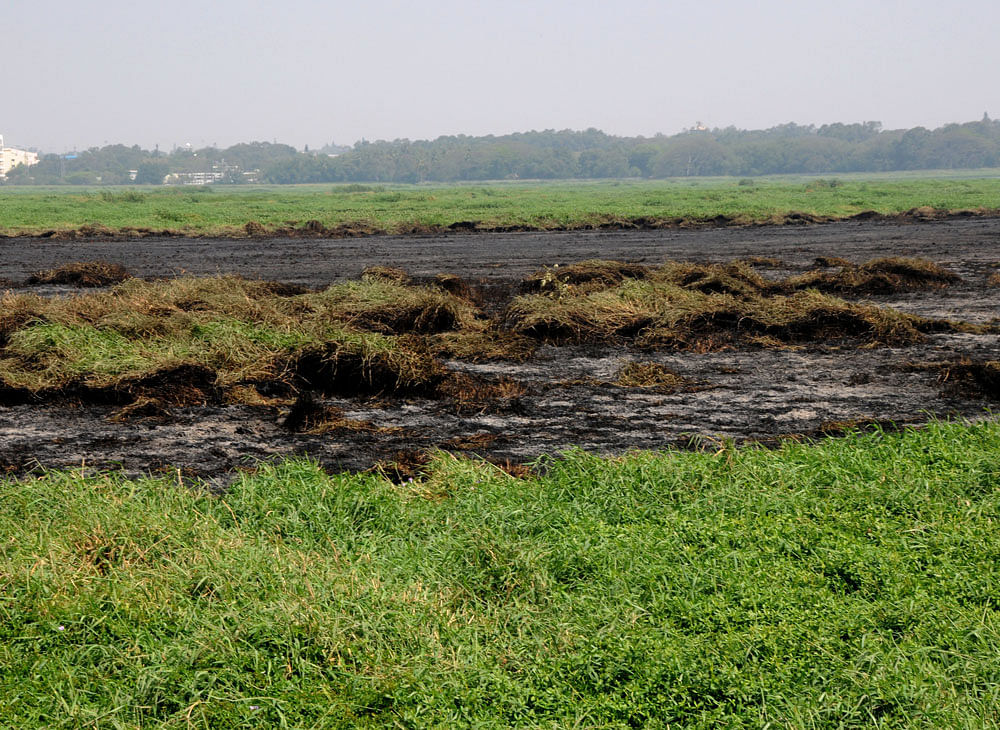KLCDA plans to implement wetlands model to revive polluted lake
Last Updated IST

A part of the lake scarred by an accidental fire early this year. DH file photo.
While the urban development department is chalking out engineering methods to revive the 900-acre Bellandur lake, the Karnataka Lake Conservation and Development Authority (KLCDA) is planning to implement the wetland model for cleaning the lake and conserving it.
G Vidyasagar, KLCDA chief executive officer told DH that it is first important to stop dumping in the lake and work on that has already started. Then the work on reviving the lake is needed.
“The wetland concept is cheaper and faster. Of course, it calls for periodic maintenance which can be done. This will be discussed with stakeholders on Friday. We also have to see how to handle hyacinth and silt accumulated over the years. KLCDA will discuss with IISc also,” he said.
The wetland concept implemented by Prof C R Babu at the Yamuna Biodiversity Park in New Delhi and Prof T V Ramachandra in Jakkur lake are very inspiring, he said. Inputs from these two models will be taken for reviving Bellandur and Varthur lakes, he added. KLCDA also introduced the engineered wetland model on Agara lake and it has shown positive results, he said.
The engineered wetland model includes mechanical, biological and purification methods to treat sewage and clean a water body. But the wetland concept is purely biological where plants which absorb nutrients and clean the water body are introduced.
Ramachandra from Centre for Ecological Sciences, IISc said the wetland concept is cost-effective. But the biggest challenge before the government is to stop the 400 mld of sewage entering the lake.
“We started implementing the wetland model in Jakkur lake in 2005, when the nitrate level was very high. Earlier, Bellandur lake too had a lot of wetlands, which people thought were a waste and removed them. They also encroached the area. A small wetland patch is seen towards the area abutting the defence land,” he said.
Ramachandra explained that the model is very simple. A bed of plants like Colocasia, Typha and Pandana, are introduced into the lake. These plants are commonly found and have the ability to absorb nutrients like nitrogen and phosphorus which conventional sewage treatment plants cannot clean. Also, installing a tertiary treatment plant in such a large water body is a very costly affair.
“But now, even after introducing all this, the lake will not get cleaned in two weeks.
The government has to stop the sewage immediately,” he said.
G Vidyasagar, KLCDA chief executive officer told DH that it is first important to stop dumping in the lake and work on that has already started. Then the work on reviving the lake is needed.
“The wetland concept is cheaper and faster. Of course, it calls for periodic maintenance which can be done. This will be discussed with stakeholders on Friday. We also have to see how to handle hyacinth and silt accumulated over the years. KLCDA will discuss with IISc also,” he said.
The wetland concept implemented by Prof C R Babu at the Yamuna Biodiversity Park in New Delhi and Prof T V Ramachandra in Jakkur lake are very inspiring, he said. Inputs from these two models will be taken for reviving Bellandur and Varthur lakes, he added. KLCDA also introduced the engineered wetland model on Agara lake and it has shown positive results, he said.
The engineered wetland model includes mechanical, biological and purification methods to treat sewage and clean a water body. But the wetland concept is purely biological where plants which absorb nutrients and clean the water body are introduced.
Ramachandra from Centre for Ecological Sciences, IISc said the wetland concept is cost-effective. But the biggest challenge before the government is to stop the 400 mld of sewage entering the lake.
“We started implementing the wetland model in Jakkur lake in 2005, when the nitrate level was very high. Earlier, Bellandur lake too had a lot of wetlands, which people thought were a waste and removed them. They also encroached the area. A small wetland patch is seen towards the area abutting the defence land,” he said.
Ramachandra explained that the model is very simple. A bed of plants like Colocasia, Typha and Pandana, are introduced into the lake. These plants are commonly found and have the ability to absorb nutrients like nitrogen and phosphorus which conventional sewage treatment plants cannot clean. Also, installing a tertiary treatment plant in such a large water body is a very costly affair.
“But now, even after introducing all this, the lake will not get cleaned in two weeks.
The government has to stop the sewage immediately,” he said.